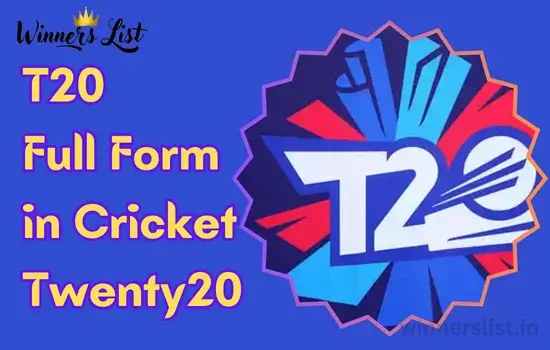T20 Full Form in Cricket: T20 stands for Twenty20, a thrilling format of cricket where each team plays 20 overs. It’s fast, it’s explosive, and it has revolutionized the way the game is played and consumed.
In this article, we’ll explore:
- The full form and origin of T20 cricket
- Key features of the T20 format
- Why it’s so popular
- Its massive impact on Indian and global cricket
- A handy comparison table of Test, ODI, and T20 formats
📌 What is T20 in Cricket?

T20 or Twenty20 cricket is a short-form version of the game. Each team gets just 20 overs to bat, making the format quick and action-packed. Unlike Test cricket, which runs for five days, a T20 match wraps up in under three hours — perfect for today’s fast-paced world.
📖 History and Origin of T20 Cricket
- Introduced by: England and Wales Cricket Board (ECB)
- Year: 2003 (domestic cricket)
- First international match: 2005 (Australia vs. New Zealand)
- T20 World Cup debut: 2007 (India won the inaugural title under MS Dhoni)
T20 was originally created to rejuvenate cricket and attract younger audiences — and it worked spectacularly!
🔥 Key Features of T20 Cricket
- Here’s what makes T20 stand out:
- Each team gets 20 overs
- Maximum 4 overs per bowler
- 6-over Powerplay restricts field placements
- Super Overs decide tied matches
- Emphasis on big hitting, fast scoring, and high energy
🧾 Comparison Table: Test vs ODI vs T20 Cricket
| Feature | Test Cricket | ODI (50 Overs) | T20 (Twenty20) |
|---|---|---|---|
| Overs per innings | Unlimited | 50 | 20 |
| Match duration | 5 Days | ~8 hours | ~3 hours |
| Fielding restrictions | Yes (varied) | Powerplays | Strict Powerplays |
| Max overs per bowler | No limit | 10 | 4 |
| Entertainment factor | Moderate | High | Very High |
| Popularity (Youth) | Low to Moderate | High | Extremely High |
T20 Cricket and India – A Perfect Match
India’s love affair with T20 began in 2007 when the Men in Blue lifted the first-ever ICC T20 World Cup. That victory triggered the launch of the Indian Premier League (IPL) in 2008.
The IPL has since become the world’s richest cricket league, attracting global stars and creating legends like:
- MS Dhoni
- Virat Kohli
- Rohit Sharma
- Suryakumar Yadav
- Hardik Pandya
💡 Why is T20 So Popular?
- 🎯 Short Duration – Done in 3 hours
- 🎆 Big Shots and Big Drama – Sixes, boundaries, thrillers
- 📺 TV- and Mobile-Friendly – Perfect for modern lifestyles
- 🌍 Global Appeal – Played in over 100 countries
- 📈 Career Opportunities – Youngsters break into the spotlight faster
🌐 Global Impact of T20 Cricket
The success of T20 has inspired several leagues worldwide:
- Big Bash League (BBL) – Australia
- Pakistan Super League (PSL)
- Caribbean Premier League (CPL)
- SA20, The Hundred, and more
It’s also helped spread cricket to newer markets like the USA, UAE, and even Germany!
🏁 Conclusion
T20, or Twenty20 cricket, is not just a format — it’s a global movement. Fast-paced, intense, and full of fireworks, T20 has breathed new life into cricket. For India and many cricket-loving nations, it’s the perfect blend of tradition and modernity.
Whether you’re a budding cricketer or just a fan with popcorn in hand, T20 cricket is where all the action is!

Hello, I’m Kapil Kumar, a seasoned SEO expert and blogger at WinnersList.in. My mission is to spotlight exceptional individuals and organizations across various domains. Through curated lists, profiles, and inspiring stories, I aim to celebrate outstanding achievements and inspire the next generation of champions. Join me in this journey.
